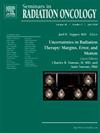Managing Patients with Head and Neck Cancer and Advanced Age or Comorbidities
IF 3.2
3区 医学
Q3 ONCOLOGY
引用次数: 0
Abstract
The dominant treatment paradigm for locoregionally advanced head and neck squamous cell carcinoma (HNSCC) involves postoperative or definitive radiotherapy with concurrent cisplatin chemotherapy. Despite years of research investigating de-intensified treatment, cisplatin-based chemoradiotherapy remains the standard, yet it is associated with significant acute and chronic toxicity. However, due to shared risk factors, such as advanced age, and tobacco and alcohol use, patients with HNSCC frequently have comorbid illnesses that impact treatment tolerability, adding complexity to treatment-related decision-making. In addition, many patients have medical contraindications to cisplatin, requiring alternative treatment strategies. It is thus important to consider how well patients are likely to tolerate treatment, and how to adapt treatment in response to a patient's condition, when weighing treatment options. In this review, we aim to offer readers guidance in managing the elderly or comorbid patient with HNSCC, with particular attention to (i) approaching comorbidity and fragility assessment to make determinations on intensity of treatment, (ii) considering primary treatment modality (eg, surgery vs radiotherapy, chemo-radiotherapy vs radiotherapy alone) and (iii) choice of concurrent systemic therapy agent.
头颈癌和高龄或合并症患者的管理
局部晚期头颈部鳞状细胞癌(HNSCC)的主要治疗模式包括术后或最终放疗合并顺铂化疗。尽管多年来对去强化治疗的研究,以顺铂为基础的放化疗仍然是标准,但它与显著的急性和慢性毒性有关。然而,由于共同的危险因素,如高龄、吸烟和饮酒,HNSCC患者经常有影响治疗耐受性的合并症,增加了治疗相关决策的复杂性。此外,许多患者有顺铂的医学禁忌症,需要替代治疗策略。因此,在权衡治疗方案时,重要的是要考虑患者对治疗的耐受程度,以及如何根据患者的病情调整治疗。在这篇综述中,我们的目的是为读者提供管理老年或合并症的HNSCC患者的指导,特别注意(i)走近合并症和脆弱性评估,以确定治疗强度,(ii)考虑主要治疗方式(例如,手术与放疗,化疗-放疗与单独放疗)和(iii)选择同步全身治疗药物。
本文章由计算机程序翻译,如有差异,请以英文原文为准。
求助全文
约1分钟内获得全文
求助全文
来源期刊
CiteScore
5.80
自引率
0.00%
发文量
48
审稿时长
>12 weeks
期刊介绍:
Each issue of Seminars in Radiation Oncology is compiled by a guest editor to address a specific topic in the specialty, presenting definitive information on areas of rapid change and development. A significant number of articles report new scientific information. Topics covered include tumor biology, diagnosis, medical and surgical management of the patient, and new technologies.

 求助内容:
求助内容: 应助结果提醒方式:
应助结果提醒方式:


